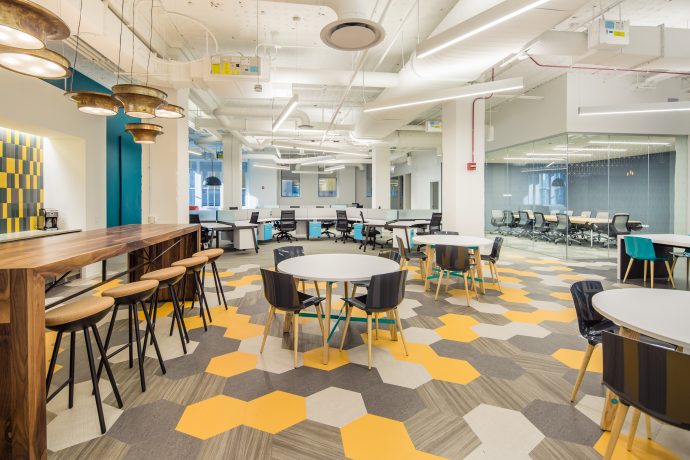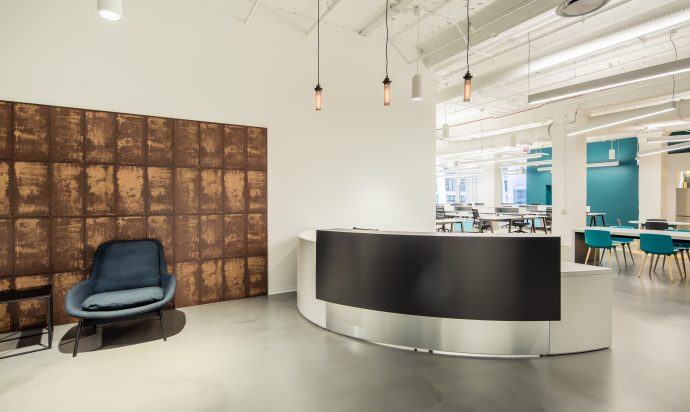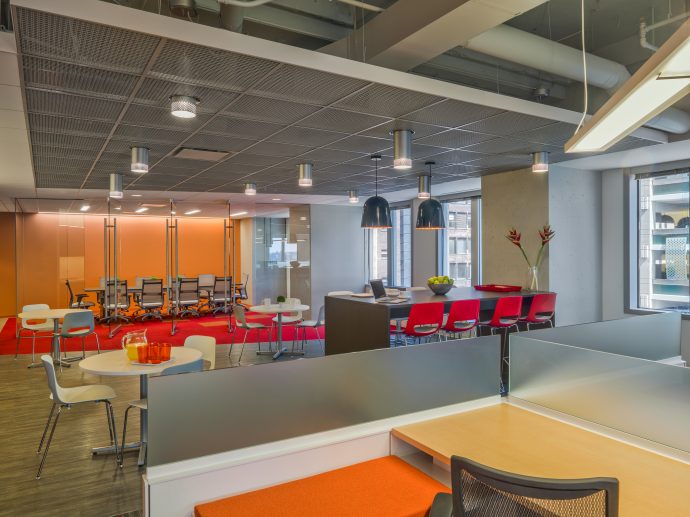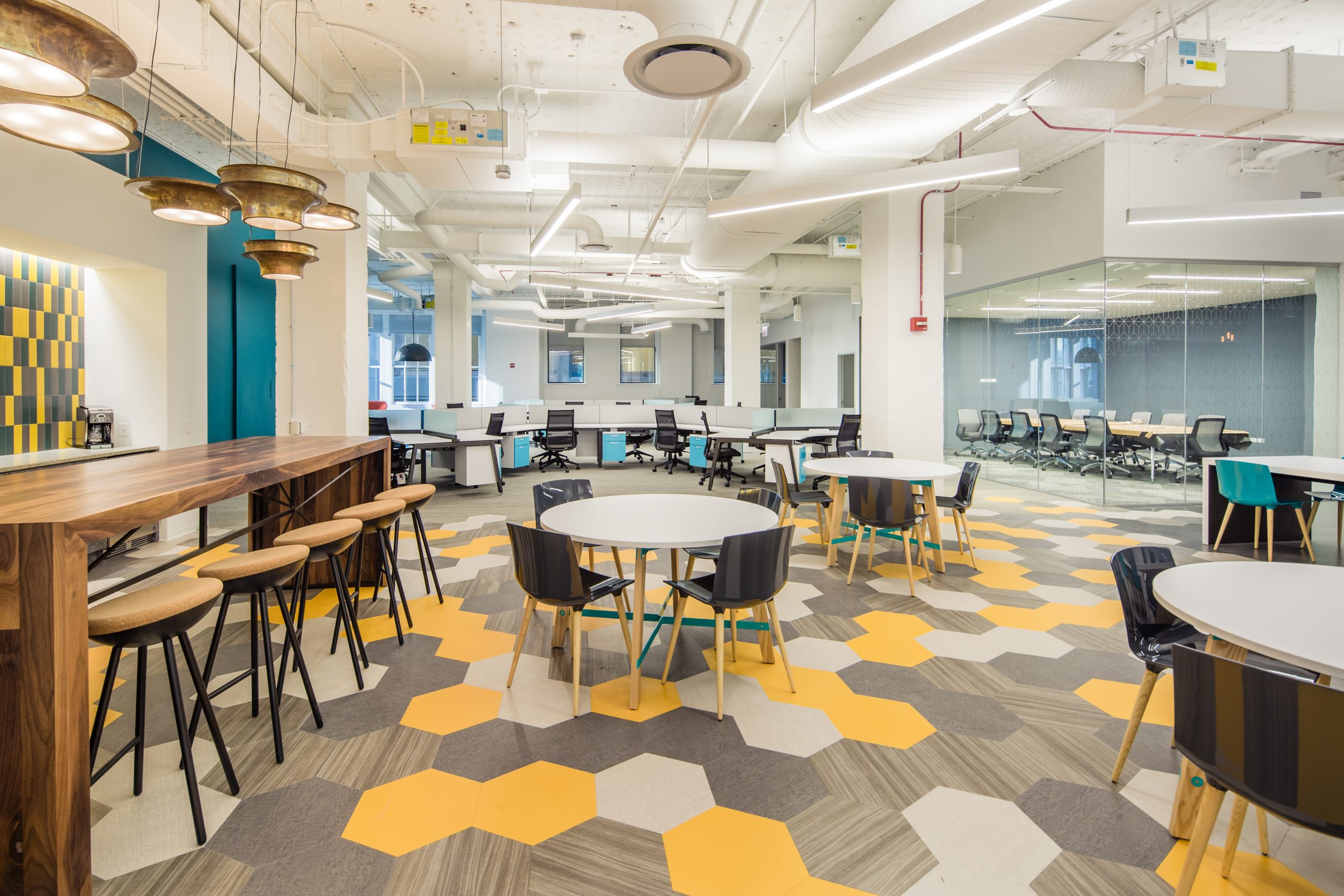Scott Delano, design director at Wright Heerema Architects, believes that designers and architects need to be responsible for stopping the sameness that plagues office space design and offers several ways to create a space that is truly differentiated.
 Find opportunities to leave a lasting impression with uniquely designed common areas. Photo courtesy of Wright Heerema Architects. © 2018 Josh Pabst Photo.
Find opportunities to leave a lasting impression with uniquely designed common areas. Photo courtesy of Wright Heerema Architects. © 2018 Josh Pabst Photo.
These days a Wi-Fi connection is all it takes to develop serious office envy. When a few clicks in a browser can take you inside the world’s “coolest” offices, expectations instantly rise for unique amenities and features—from hip office bars to the truly extraordinary. Think treehouse-style workspaces and custom game rooms.
Unfortunately, that bubble bursts for many office tenants when they start touring spec suites in real life. They see space after space that resembles one another, like walking through a row of cookie-cutter houses in a master plan community.
The reality is that not every organization needs or wants a highly customized office, particularly if they have a short timeline, limited budget or uncertain growth projections. But everyone does want a space that works for their company culture and inspires their employees to do their best work.
By nature, spec suites are designed to appeal to the most tenants possible—plug-and-play spaces that fit the needs of just about anyone who needs square footage for desks and meeting areas. In turn, spec suite design is becoming more formulaic as architects and designers work from a common set of requirements. When all suites have a similar ratio of open workstations to desks to conference rooms, it’s hard to find opportunities to differentiate one suite from another space in the building down the street.
Building owners who want their space to stand out will be happy to know that designing a spec suite doesn’t have to be a paint-by-number exercise. Through creative, use-oriented design and some added effort, it’s possible to break the mold to create a space that is truly differentiated.
Focus on opportunities to up the “wow” factor
After potential tenants tour multiple buildings, different spaces can blur together in their minds when it comes time to evaluate the options. That’s why it’s important to create beautiful, powerful moments in your space that leave a strong, positive impression.
Workstations and individual offices don’t necessarily offer the best opportunity to be unique since their requirements are relatively common when creating a spec suite. Instead, put energy into areas that might have more flexible interpretations, such as café spaces, huddle areas and other common areas.
At 1 N. Dearborn in Chicago, a thoughtfully designed spec suite pays homage to the building’s history while providing a modern and bright workspace. A spacious café area offers ample seating as an alterative work area and gathering space, with carefully selected finishes that lend a cheery vibe. And cozy nooks in the corners offer the opportunity for employees to enjoy city views from the expansive windows.

…But look beyond the finishes
Often designers lean heavily on light fixtures and wall treatments to brighten up an otherwise humdrum space. The challenge is that if two spaces have the exact same plan and layout, the finishes aren’t likely to make that much of a difference. This is particularly true when the renovation budget is limited. Typically, less than 50 percent of fit-out spend is on features that can be affected architecturally; the rest is mechanical, plumbing and other infrastructure. That doesn’t leave much left over for high-end furniture or other finishes.
The most compelling spaces don’t stand out because they have cool lights or fun carpet; it’s about how a space functions for the occupants. Steve Jobs encapsulated this idea so well:
Most people make the mistake of thinking design is what it looks like. People think it’s this veneer – that the designers are handed this box and told, ‘Make it look good!’ That’s not what we think design is. It’s not just what it looks like and feels like. Design is how it works. – Steve Jobs
Maybe the legendary designer was thinking about technology when he spoke those words, but the same idea applies to real estate. When a potential tenant tours a space, it’s important for them to see how their company will work in that space. “Wow” moments leave an impression; and unique features can be the deciding factor in a leasing decision.
It’s important to explore architectural features that have unique functional purposes. For example, a moveable wall between a training room and café area can create a multi-purpose space that can be used for evening client events, alternative workspaces for employees and more. There are always moments in any building that can be expressed as a feature through the spec suite design – focus a great view through the design, express the building’s industrial past, or tell a small portion of the building’s story. Connecting the spec suite to the unique place that it occupies helps to deepen the connection and memory of the space.

Design with the target audience and adaptability in mind
One challenge of spec suites will never change: It’s hard to be all things to all people. The owner of a tech startup typically seeks a different office vibe than an established law firm. Depending on the type of tenants an owner is trying to attract, it is possible customize the space to be more appealing to those types of companies.
For example, professional services companies typically seek a more traditional, “grown-up office.” Law and financial firms in particular typically require more private offices compared to open workspace. Technology, advertising and media companies, on the other hand, appreciate open work areas and will accept a little more edginess. A space that looks like it had a prior life lends a feeling of authenticity that can help keep the creative juices flowing.
Regardless of the type of company, most tenants want a space that’s adaptable. Plan for the future by creating expansion areas that can easily accommodate short-term growth for tenants. It’s also important to maintain a balance of open workstation seats to conference room seats so there is always a place to meet (even when the office is at its densest).
Keeping these trends in mind, building owners at 222 S. Riverside and 311 S. Wacker in Chicago, sought to redesign their spec suites to offer flexible, open and collaborative work environments. The spec suites feature private offices and conference rooms with full glass walls and low workstation panels that maximize views and provide an abundance of natural light.

In a technology-driven world, no one wants to be left with nowhere to plug in. A multitude of unobtrusive charging stations, even ones that pull down from the ceiling, makes it easy for flex-time employees, freelancers, visitors from remote offices, and guests to charge up and work. Similarly, accounting for the highest-speed Wi-Fi and other technology concerns during the design process is a must.
Just say ‘no’ to cookie cutter offices
Designers and architects have a responsibility to stop contributing to the sameness that plagues offices spaces. When we work with building owners to create beautiful, memorable space that stands above the crowd, everyone wins. We see designs we can be proud of. Building owners lease their space more quickly. And tenants can thrive in work spaces that support the unique ways they work (without the high price tag). That’s what we call a win-win-win.



This is real art. These tips still need to have a talent